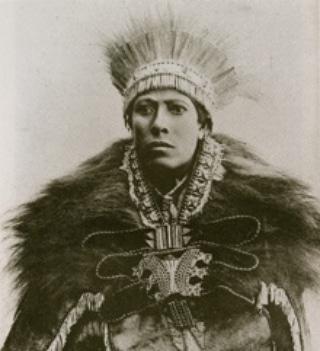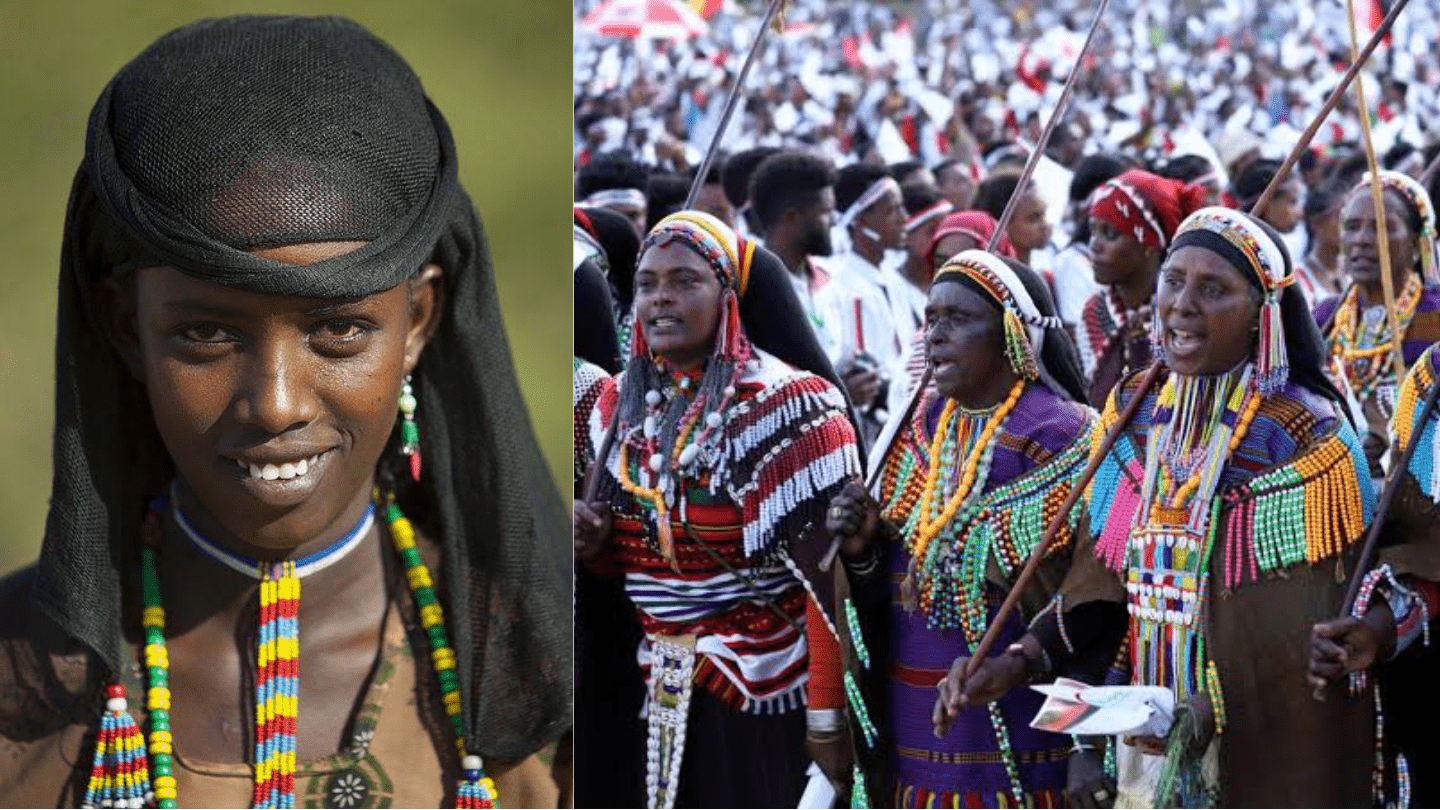The Oromo are a Cushitic ethnic group and nation indigenous to Ethiopia and Kenya who speak the Oromo language. They are Ethiopia’s largest ethnic group, accounting for 34.5 percent of the country’s population. Oromos speak the Oromo language (also known as Afaan Oromoo and Oromiffa), which is part of the Cushitic branch of the Afroasiatic language family.
55% – 60% of the Oromo are Muslims, 40% – 45% are Christian, and up to 15% Traditional religion (Waaqeffanna)
Some Oromo people continue to practice their traditional religion, Waaqeffanna, and use the gadaa system of governance. A leader elected through the gadaa system is often in office for eight years, with an election held at the end of that term.
Prior to the 16th century, the Oromo people’s origins and prehistory were based on folk tales. Older and subsequent colonial-era documents refer to the Oromo people as Galla, a derogatory term, but these documents were generally written by representatives of other ethnic groups.
The first verifiable record of the Oromo people being mentioned by a European cartographer is in a 1460 map by the Italian Fra Mauro, which uses the word “Galla.”
However, until the early twentieth century, Fra Mauro’s word Kush was the most commonly used. The word coined by Juxon Barton in 1924 was used by Abyssinians and Arabs to refer to Oromo people. It was a metaphor for a river, a forest, and a pastoral people who lived in the highlands of southern Ethiopia.
According to Mohammed Hassen, this historical knowledge is consistent with Somali written and oral traditions.
According to an International African Institute journal, it is an Oromo word (adopted by neighbors), as there is a word galla in their language that means “wandering” or “to go home.”
The Oromo have never called themselves “Galla” and refuse to use the word because it is considered negative.
They used to identify themselves by one of their clans (gosas), but now use the generic term Oromo, which means “free born people.” Oromo is derived from the word Ilm Orma, which means “children of Oromo,” “sons of Men,” or “person, stranger.” The term Oromo was first used to refer to an ethnic group in 1893.
Oromoo people heavily contributed to the battle of Adwa which led to the defeat of Italian troops in 1896.
As historian Raymond Jonas points out in his book The Battle of Adwa, the appearance of Oromo cavalrymen at the Battle of Adwa had a “notably dispiriting effect on the Italian soldiers. The Oromo functioned with such grim efficiency that they hastened the demoralization of the crumbling Italian army.” – Aljazeera

Origin
Following Fra Mauro’s statement, there has been a number of literature about the inhabitants of this area, including the Oromo, specifically mentioning their wars and resistance to religious conversion, mainly by European explorers and Catholic Christian missionaries.
The oldest historical report of Oromo ethnography is the 16th-century “History of Galla” written in Ge’ez by Christian monk Bahrey from the Sidama country of Gammo.
According to D’Abbadie’s book from 1861. In some maps and historical events, the Oromo are referred to as the Galla. Before the (Oromo expansion), the Oromo led a campaign against the Sultanate of Ifat, which was called Meeshii Dir Dhabe. The Oromo led an expedition against the Cisee Dir clan, who occupied the great city.
The Cisse clan would be dominant, bringing the war to a halt. The Cisee would rule the city for the next two centuries, before the Oromo expanded and migrated. According to an Oromo inscription from the 14th century, the Oromo were in Ethiopia long before the Oromo migration and established several civilisations, including the Wej,Bale,Arsi,Dawaro, and others.
Sihabudin also stated that the Werra Qallo, who now live in Hararghe, were in Dawaro long before the Oromo migration.
Historical evidence indicates that the Oromo people were already settled in the southern highlands in or before the 15th century, and that at least some Oromo people interacted with other Ethiopian ethnic groups.
According to Alessandro Triulzi The Oromo would make contact with and communicate with the Nilo Saharan Groups.
According to historical linguistics and comparative ethnology studies, the Oromo people most likely originated near the lakes Lake Chew Bahir and Lake Chamo.
They are a Cushitic people who have lived in East and Northeast Africa since at least the early first millennium. The Abyssinian–Adal war of the sixteenth century forced the Oromos to relocate to the north.
The Harla were assimilated by the Oromo in Ethiopia. While Oromo people have lived in the area for a long time, the ethnic mix of peoples who have lived here is unknown.
The Oromos expanded their population through Oromization (Meedhicca, Mogasa, and Gudifacha), assimilation, and forced assimilation of other ethnic groups, as well as the inclusion of mixed peoples (Gabbaro).
The native ancient names of the territories were replaced by the names of the Oromo clans who conquered them, and the inhabitants were renamed Gabbaros.
History
Pre-19th century
Afaan Oromo-speaking people have traditionally used their own Gadaa system of governance. The Oromos also had a number of autonomous kingdoms that they shared with the Sidama. The Gibe region kingdoms of Kaffa, Gera, Gomma, Garo, Gumma, Jimma, Leeqa-Nekemte, and Limmu-Ennarea were among them.
The Ethiopian monk Abba Bahrey wrote Zenahu le Galla in 1593, the earliest known written and comprehensive history of the Oromo people, though the synonymous word Gallas was recorded in maps or elsewhere much earlier.
They are mentioned more frequently after the 16th century, such as in the records left by Abba Pawlos, Joao Bermudes, Jerorimo Lobo, Galawdewos, Sarsa Dengel, and others. According to these documents, the Oromo were a pastoral people who lived together in the past. Their animal herds started to grow exponentially, necessitating the need for more grazing lands. They started migrating individually, rather than together.
Instead of kings, they had elected leaders known as luba who were governed by a gada structure. By the late 16th century, two major Oromo confederations had emerged: Afre and Sadaqa, which refer to four and three in their language, respectively, with Afre emerging from four older clans and Sadaqa emerging from three.
These Oromo confederations were originally based in south-central Ethiopia, specifically the northwest of the Borena Zone near Lake Abaya, but began migrating north in the 16th century, coinciding with the “Great Oromo Migration.”
According to Richard Pankhurst, an Ethiopian scholar, this migration is related to Imam Ahmad ibn Ibrahim’s first incursions into inland Horn of Africa.
According to historian Marianne Bechhaus-Gerst, the migration was one of the consequences of fierce attrition wars between Christian and Muslim armies in the Horn of Africa area in the 15th and 16th centuries, which killed many people and depopulated the regions near the Galla lands, but it was also most likely a result of droughts in their traditional homelands.
Furthermore, they captured horses, and their gada system assisted in the organization of well-equipped Oromo warriors, enabling fellow Oromos to advance and settle into newer regions beginning in the 1520s. This expansion lasted until the 17th century.
Both peaceful integration and violent competition between Oromos and other neighboring ethnicities such as the Amhara, Sidama, Afar, and Somali influenced Oromo politics.
Between 1500 and 1800, there were waves of wars and conflict in the Horn of Africa between highland Christians, coastal Muslims, and polytheists. This resulted in substantial population displacement. Around 1535, the Oromos marched north, east, and west from the south, mirroring the Somalis’ large-scale inland expansion. The Amhara people were also displaced during the 1500–1800 period, which influenced contemporary ethnic politics in Ethiopia.
According to oral and written evidence, the Borana Oromo clan and the Garre Somali clan victimized each other in the seventeenth and eighteenth centuries, particularly near their eastern borders. There were also times of relative tranquillity.
According to Günther Schlee, the Garre Somali clan has displaced the Borana Oromo clan as the region’s dominant ethnic group. According to Schlee, the Borana violence against their neighbors was unprecedented and unlike their actions within their culture, where violence was considered deviant.
Demographics
The Oromos are Ethiopia’s largest ethnic group (34.9 percent of the population), numbering about 37 million people. They are primarily concentrated in the Oromia Region of central Ethiopia, the country’s largest region in terms of both population and territory. They communicate in Afaan Oromoo, Oromia’s official language. Oromos are the third most populous ethnic group among Africans in general, and the most populous among Horners in particular.
The Oromo also have a significant presence in northern Kenya, especially in Marsabit County, Isiolo County, and Tana River County.
Totaling approximately 470,700: 210,000 Borana, 110,500 Gabra, 85,000 Orma, 45,200 Sakuye, and 20,000 Waata. There are also Oromo in Ethiopia’s former Wollo and Tigray provinces.
Subgroups
Main article: List of Oromo subgroups and clans
The Oromo are divided into two main branches, which are further subdivided into a variety of clan families. From west to east. The Borana Oromo, also known as the Booranaa, are a semi-pastoralist tribe that live in southern Oromia and northern Kenya. The Borana live in the Borena Zone of Ethiopia’s Oromia Region and the former Northern Frontier District (now northern Kenya) of Northern Kenya.
They communicate in an Afaan Oromo dialect. The Oromo language. The Oromo people’s other moiety is the Barentu/Barentoo or (older) Baraytuma. The Barentu Oromo are located in the eastern parts of the Oromia Region in the Zones of West Hararghe, Arsi Zone, Bale Zone, Dire Dawa Region, the Jijiga Zone of the Somali Region, Administrative Zone 3 of the Afar Region, the Oromia Zone of the Amhara Region, and the Raya Azebo Aanaas in the Tigray Region.
 The African History Truly African
The African History Truly African

